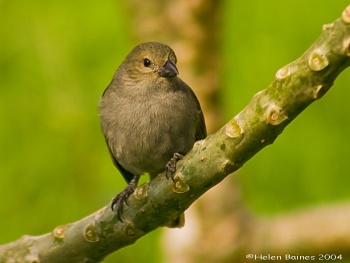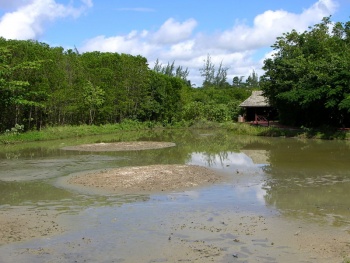| This article is incomplete. This article is missing one or more sections. You can help the BirdForum Opus by expanding it. |
Overview
Barbados is 13° North of the equator and 59° West. It is part of the Lesser Antilles island-chain in the Caribbean. It's closest island neighbours are Saint Vincent and Saint Lucia to the west. Barbados's total land area is about 430 square kilometres (166 square miles), and is primarily low-lying, with some higher regions in the country's interior. Undeveloped areas of the country contain tropical woodland and scrubland.
Birds
Notable Species
The only endemic species is Barbados Bullfinch which in the past was considered a local subspecies of Lesser Antillean Bullfinch. Other notable species are a distinctive subspecies of Yellow Warbler which is found around Graeme Hall Swamp. The largest breeding colony of Little Egret in the western hemisphere is found here. A relatively large number of European species have been seen here, such as vagrant Grey Heron or different ducks. Southern Lapwing is a species which recently was breeding in Barbados after arriving as a vagrant species, but the remaining two birds (2013) seem to be females while the male was shot a couple of years earlier.

The Barbados Bullfinch, previously considered a subspecies of the Lesser Antillean Bullfinch
Rarities
White-winged Tern, Arctic Tern, Spotted Redshank, Black Kite, Grey Heron, Eurasian Spoonbill, Black-headed Gull, Lesser Black-backed Gull, Gull-billed Tern, Pacific Golden Plover, Upland Sandpiper, Garganey, Brown Pelican, Fork-tailed Flycatcher, Short-eared Owl, Purple Heron, Glossy Ibis, Northern Pintail, Yellow-legged Gull, Anhinga, Franklin's Gull, Wilson's Phalarope, Dickcissel, Caspian Tern, Least Bittern, Black Tern, American Coot, Whiskered Tern, Northern Parula, Ovenbird, Ruff, Western Reef-Heron, Caribbean Flamingo, Eurasian Wigeon, Common Teal, Common Greenshank, Summer Tanager, White-collared Swift, Alpine Swift, Tricoloured Heron, Black-capped Petrel, European Storm-Petrel, Greater Scaup, Common Pochard.
Check-list
Birds you can see here include:
Pied-billed Grebe, Greater Shearwater, Audubon's Shearwater, Wilson's Storm Petrel, Leach's Storm Petrel, White-tailed Tropicbird, Red-billed Tropicbird, Masked Booby, Brown Booby, Red-footed Booby, Magnificent Frigatebird, Great Blue Heron, Great Egret, Little Egret, Snowy Egret, Little Blue Heron, Tricolored Heron, Cattle Egret, Green Heron, Yellow-crowned Night-Heron, Black-bellied Whistling Duck, White-cheeked Pintail, Blue-winged Teal, American Wigeon, Northern Shoveler, Lesser Scaup, Ruddy Duck, Masked Duck, Osprey, Merlin, Peregrine, Sora, Common Gallinule, Black-bellied Plover, Americal Golden Plover, Semipalmated Plover, Wilson's Plover, Killdeer, American Oystercatcher, Black-necked Stilt, Greater Yellowlegs, Lesser Yellowlegs, Willet, Solitary Sandpiper, Spoted Sandpiper, Whimbrel, Hudsonian Godwit, Marbled Godwit, Ruddy Turnstone, Red Knot, Sanderling, Semipalmated Sandpiper, Western Sandpiper, Least Sandpiper, White-rumped Sandpiper, Pectoral Sandpiper, Stilt Sandpiper, Short-billed Dowitcher, Wilson's Snipe Bananaquit, Roseate Tern, Laughing Gull, Shiny Cowbird, Carib Grackle, Common Ground Dove, Eared Dove, Zenaida Dove, Cattle Egret, Antillean Crested Hummingbird, Green-throated Carib, Scaly-naped Pigeon, Black-faced Grassquit, Black-whiskered Vireo, and Gray Kingbird.
This list exclude vagrants. Red-tailed Hawk has been extirpated from Barbados.
Other Wildlife
African Green Monkey and Mongoose are naturalized on the island.
Site Information
History and Use
To do
Areas of Interest
Graeme Hall Nature Sanctuary, Woodbourne Shorebird Reserve, Chancery Lane Swamp, Folkestone Marine Park and Barbados Wildlife Reserve
NB: The Graeme Hall Nature Sanctuary closed permanently on Dec. 15th, 2008. See their website for more details. At the beginning of 2011, the Sanctuary Cafe and Lakeside Lawn were opened to the public on a limited basis, but there are no tours of the rest of the facility, and all walkways, aviaries and exhibits remain closed to the public. Hours: Mon-Fri: 7:30am - 5:00pm; Sat: 8:00am - 4:30pm; Sun: 9:00am - 4:30pm.

The cage with captive shorebirds and next to it a flock of wild Stilt Sandpipers at Congo Rd Swamp, a shooting swamp
January 2013
Shooting Swamps
Several shooting swamps exist in Barbados. These are man-made wetlands optimized for shorebird and duck habitat. As the name says, these have been made for hunting, and current local laws allow them to be used for that purpose three month of the year (the fall migration). They are included here because several of them are used for birdwatching at other times of the year. Unfortunately, several of them have a cage with living shorebirds to attract wild birds to the area. Shooting swamps currently (2013) in use include swamps at Congo Rd, Golden Grove, and Alaska (and possibly others).
The Woodbourne Shorebird Reserve mentioned above is a former shooting swamp that now is maintained as a bird sanctuary.
Gallery
Click on image to see larger version
Photo by HelenB
An animal enclosure at the Barbados Wildlife ReservePhoto by HelenB
The Barbados Wildlife Reserve has plenty of wild birds to see around the enclosures
Access and Facilities
Barbados has a large international airport with direct flights to cities in both Europe, USA, and Canada, and to several other islands in the Caribbean.
Contact Details
To do
External Links
Pages in category ‘Barbados’
The following 2 pages are in this category, out of 2 total.







